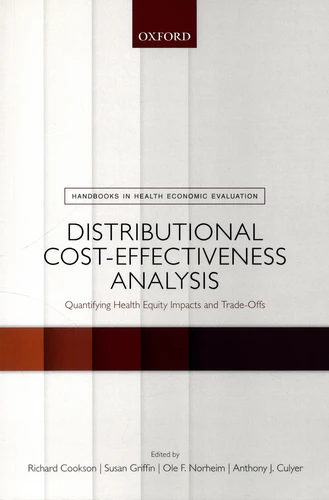Distributional Cost-Effectiveness Analysis. Quantifying Health Equity Impacts and Trade-Offs
Par : , , ,Formats :
- Paiement en ligne :
- Livraison à domicile ou en point Mondial Relay indisponible
- Retrait Click and Collect en magasin gratuit
- Réservation en ligne avec paiement en magasin :
- Indisponible pour réserver et payer en magasin
- Nombre de pages380
- PrésentationBroché
- FormatGrand Format
- Poids0.585 kg
- Dimensions15,6 cm × 23,5 cm × 2,1 cm
- ISBN978-0-19-883819-7
- EAN9780198838197
- Date de parution01/09/2020
- ÉditeurOxford University Press
Résumé
Distributional cost-effectiveness analysis aims to help healthcare and public health organizations make fairer decisions with better outcomes. It can provide information about equity in the distribution of costs and effects — who gains, who loses, and by how much - and the trade-offs that sometimes occur between equity and efficiency. This is a practical guide to methods for quantifying the equity impacts of health programmes in high, middle, and low-income countries.
The methods can be tailored to analyse different equity concerns in different decision making contexts. The handbook provides both hands-on training for postgraduate students and analysts and an accessible guide for academics, practitioners, managers, policymakers, and stakeholders. Part I is an introduction and overview for research commissioners, users, and producers. Parts II and III provide step-by-step guidance on how to simulate and evaluate distributions, with accompanying spreadsheet training exercises.
Part IV concludes with discussions about how to handle uncertainty about facts and disagreement about values, and the future challenges facing this growing field.
The methods can be tailored to analyse different equity concerns in different decision making contexts. The handbook provides both hands-on training for postgraduate students and analysts and an accessible guide for academics, practitioners, managers, policymakers, and stakeholders. Part I is an introduction and overview for research commissioners, users, and producers. Parts II and III provide step-by-step guidance on how to simulate and evaluate distributions, with accompanying spreadsheet training exercises.
Part IV concludes with discussions about how to handle uncertainty about facts and disagreement about values, and the future challenges facing this growing field.
Distributional cost-effectiveness analysis aims to help healthcare and public health organizations make fairer decisions with better outcomes. It can provide information about equity in the distribution of costs and effects — who gains, who loses, and by how much - and the trade-offs that sometimes occur between equity and efficiency. This is a practical guide to methods for quantifying the equity impacts of health programmes in high, middle, and low-income countries.
The methods can be tailored to analyse different equity concerns in different decision making contexts. The handbook provides both hands-on training for postgraduate students and analysts and an accessible guide for academics, practitioners, managers, policymakers, and stakeholders. Part I is an introduction and overview for research commissioners, users, and producers. Parts II and III provide step-by-step guidance on how to simulate and evaluate distributions, with accompanying spreadsheet training exercises.
Part IV concludes with discussions about how to handle uncertainty about facts and disagreement about values, and the future challenges facing this growing field.
The methods can be tailored to analyse different equity concerns in different decision making contexts. The handbook provides both hands-on training for postgraduate students and analysts and an accessible guide for academics, practitioners, managers, policymakers, and stakeholders. Part I is an introduction and overview for research commissioners, users, and producers. Parts II and III provide step-by-step guidance on how to simulate and evaluate distributions, with accompanying spreadsheet training exercises.
Part IV concludes with discussions about how to handle uncertainty about facts and disagreement about values, and the future challenges facing this growing field.


